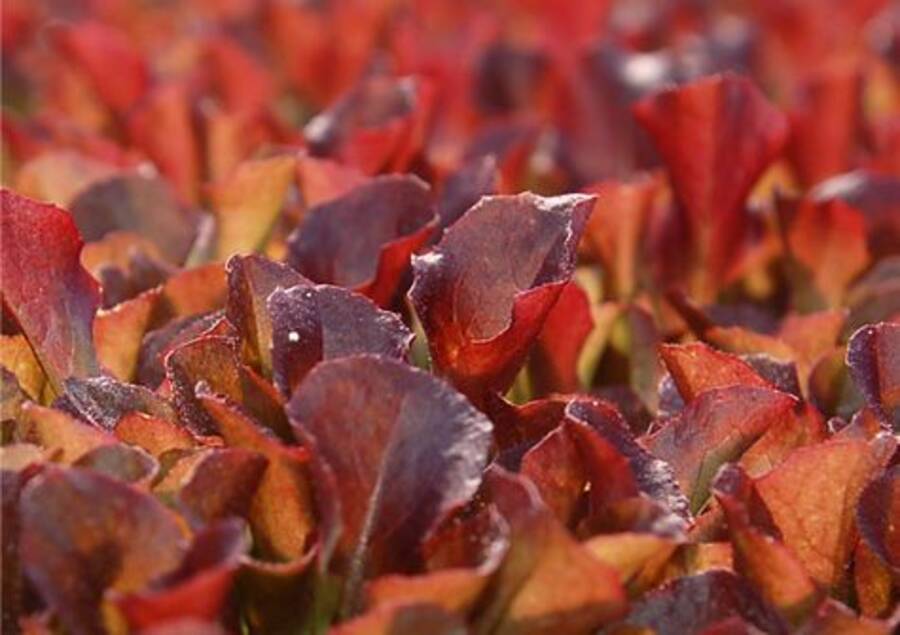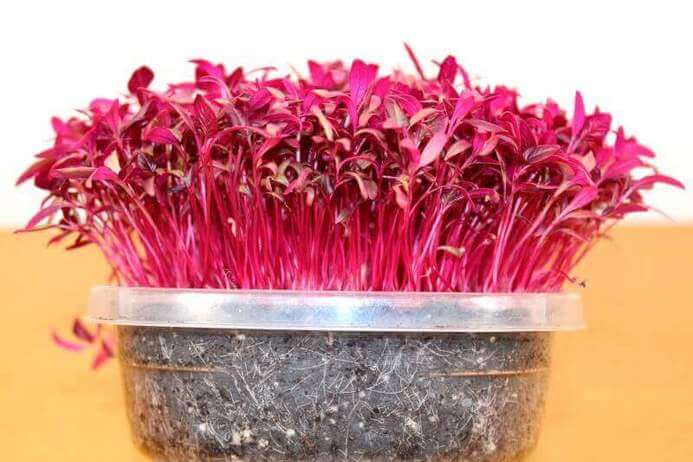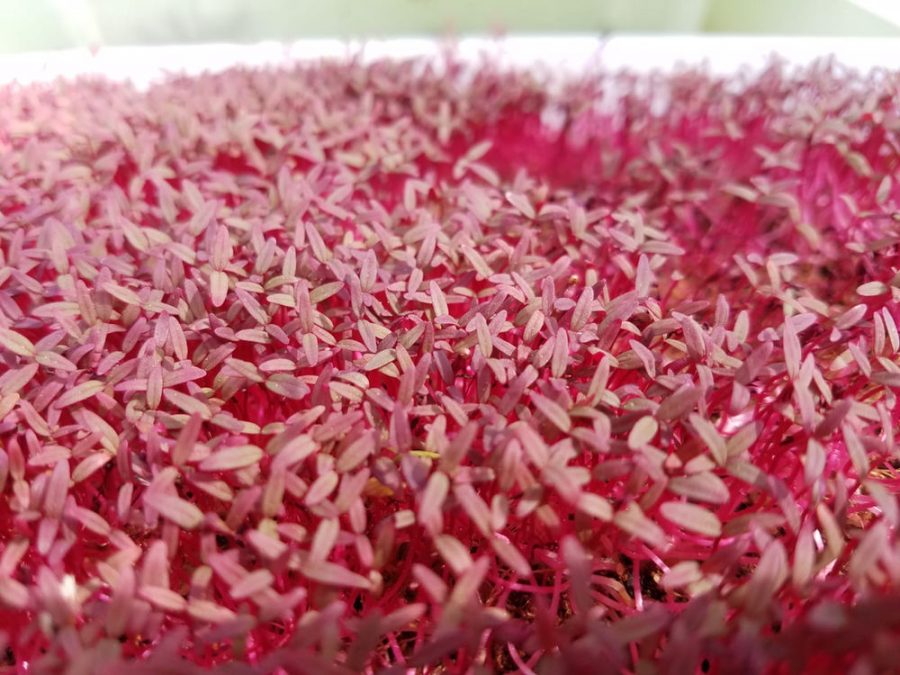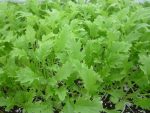This post contains affiliate links. If you buy something from one of our links we may earn a commission. Thanks

Would you like to learn how to grow amaranth microgreens? We’ll show you how in 7 easy steps and we will tell you what amaranth is and its health benefits.
What Is Amaranth?
Amaranth is an ancient grain that has been cultivated for thousands of years. It was a staple grain for the Inca and Aztec people. It’s a warm-season crop and the amaranth plant provides edible leaves, grains, and stems.
Key Takeaways:
-
How To Grow Amaranth Microgreens (In 7 Easy Steps):
• Acquire amaranth seeds, soil or coco coir, and propagation trays.
• Prepare the soil or coco coir, ensuring it’s moist but not soggy.
• Spread the seeds evenly across the soil, covering them lightly with soil.
• Mist the soil with water to keep it moist.
• Place the trays in a sunny spot or under grow lights for 6-8 hours (or 12-18 hours under grow lights) daily.
• Maintain moisture by lightly misting the soil as needed.
• Harvest the microgreens in about 10-15 days, when they reach 3-4 inches in height.
Because of its many health benefits and high nutritional value, it is now being grown as a microgreen. In this article, we will tell you how to grow amaranth microgreens for yourself.
Amaranth is gluten-free and high in protein and essential minerals like iron, calcium, magnesium, and phosphorus. It’s also packed with dietary fiber and antioxidants making it incredibly nutritious.
There are approximately 75 species in the genus, 10 of which are dioecious and native to North America with the remaining 65 monoecious species endemic to every continent (except Antarctica) from tropical lowlands to the Himalayas.
Members of this genus share many characteristics and uses with members of the closely related genus Celosia. Amaranth grain is collected from the genus. The leaves of some species are also eaten. https://en.wikipedia.org/wiki/Amaranth
Red Amaranth Vs Green Amaranth
Red amaranth appears to be more nutrient-rich than green amaranth. Research confirms this. It is also much prettier with its beautiful red color and will add more pop to your salads or other dishes.
…flavonoids, such as rutin, hyperoside, isoquercetin, myricetin, quercetin, apigenin, kaempferol, and catechin were observed in the red color amaranth genotypes, which was much higher compared to the green color amaranth genotype. https://www.ncbi.nlm.nih.gov/pmc/articles/PMC6890792/
Most green amaranth grows wild as a common weed known as pigweed by many farmers but it is also known as Chinese spinach and is used as a salad green in many Asian cultures.
Red amaranth has been developed for the food market and if you want to grow red amaranth microgreens then red amaranth is the obvious choice both for appearance and nutritional value. Red Garnet amaranth microgreens are a popular variety.
Below is a microgreen variety called Red Army available on Amazon.
How To Grow Amaranth Microgreens In 7 Easy Steps
You want to get off to a good start and here is the best way to grow your amaranth microgreens.
Just follow this step-by-step guide and you will be harvesting your amaranth microgreens in 2 weeks.
It is best to use 2 propagation trays, a top tray with drainage holes placed inside a bottom tray without holes. This will allow for bottom watering your seedlings.
Using coconut coir over potting soil is an excellent choice and provides a perfect environment for high germination rates. If you follow these steps you can grow healthy microgreens of any kind.
1. Get the right supplies – The most important thing you will need is amaranth seeds. Choose a red variety.
Choose your soil or growing medium (such as coco coir), microgreen trays to grow your microgreens in.
Tap water is ok but distilled or RO water is better. Some plants are sensitive to chloramines and fluorides.
Access to sunlight, LED grow lights, or fluorescent light bulbs.
Use a standard plant propagation tray for the best results.
2. Prepare the soil or growing medium – Mix it with water until it reaches a moist, yet not soggy state. Make the soil mixture light enough for good seedling germination if it is on the heavy side you can add some perlite to it. Amaranth is not a delicate microgreen but its seeds are small and you want to plant them in well-drained soil.
3. Plant your seeds – Spread your amaranth seeds evenly across the surface of each container or use a seed shaker and then cover them with a thin layer of soil or growing medium just enough that they are no longer visible. Lightly press down on top of the seed/soil mix for the best results. Warm temperatures will speed up the germination process.
4. Water your container – Give it enough water so that the topsoil is moist but not overly saturated. Use a misting bottle to do this. You want to avoid over-watering, so wait for the perfect time. Stick a finger in the tray to feel for moisture. You can also lift the tray to see if it feels light.
5. Place containers in sunlight or under fluorescent or LED grow lights. For best results, leave your containers in direct sunlight for at least 6 -8 hours per day if possible. If using grow lights give them 12-18 hours of light.
Microgreens require high light levels to grow properly. If you don’t have access to enough natural light, consider investing in a grow light as these can be extremely helpful when it comes to providing a consistent light source for your microgreens.
6. Make sure your containers remain moist – The key to successful micro greens is keeping them moist. Do this by lightly misting the soil with a spray bottle.
7. Harvest and enjoy! – After about 10-15 days, you’ll be able to harvest your amaranth microgreens cutting them off at soil level. The best time to harvest is right when the first true leaves start to appear. Use an extremely sharp knife or ceramic scissors and enjoy their delicious flavor, your beautiful microgreens and all their great nutritional benefits!
Use the leafy greens as an addition to salads, sandwiches, soups, or other dishes for a burst of flavor and nutrients. Enjoy the fruits of your labor or in this case the microgreens of your labor! Amaranth microgreens will have a shelf life of 7-14 days if kept refrigerated.
Amaranth Health & Nutrition Benefits:

Amaranth is a nutritional powerhouse that provides a number of health benefits and many essential vitamins, minerals, and other nutrients.
It has been studied for its potential health benefits, including reducing inflammation, promoting heart health, aiding weight loss, regulating blood sugar levels, and even preventing cancer.
One review reported that amaranth is especially high in phenolic acids, which are plant compounds that act as antioxidants. These include gallic acid, p-hydroxybenzoic acid and vanillic acid, all of which may help protect against diseases like heart disease and cancer. https://www.healthline.com/nutrition/amaranth-health-benefits
Amaranth is an excellent protein source, making it a great choice for vegetarians and vegans. It is also gluten-free, making it ideal for those with sensitivities or allergies.
It is packed with essential vitamins, minerals, and other nutrients such as protein, dietary fiber, iron, and calcium.
Amaranth also contains powerful antioxidants like quercetin and kaempferol which are known to reduce inflammation and promote heart health.
It also provides significant amounts of protein which are important for muscle growth and maintenance.
Furthermore, amaranth contains essential amino acids that cannot be produced by our bodies and must be obtained through diet.
Additionally, amaranth is believed to have anti-cancer properties and may help prevent certain types of cancer.
It may promote a healthy digestive system, regulate blood sugar levels and even aid weight loss.
Eating whole grains like amaranth may help lower your blood pressure levels. Studies show that diets rich in whole grains may decrease your risk of high blood pressure. https://www.healthline.com/nutrition/foods-high-blood-pressure
For athletes, amaranth can provide them with the extra energy they need during workouts as well as help reduce muscle fatigue after exercising.
For those looking for an extra boost of nutrition, amaranth is definitely worth adding to your diet.
With all these great health benefits, it’s no wonder why amaranth is becoming a popular choice for both health-conscious individuals and people looking to add variety to their diets.
As with any other food, you should always consult your doctor before incorporating new foods into your diet to make sure they are safe and suitable for you.
With its numerous health benefits, amaranth is definitely worth considering as part of a healthy lifestyle.

How To Use Amaranth Microgreens
Amaranth has a variety of uses and can be used in recipes such as salads, soups, casseroles, and baked goods.
In addition to using it for microgreens, it can be eaten as a whole grain or ground up into flour.
Its nutty flavor pairs well with most flavors and its high nutrient content make it an excellent addition to any diet.
So if you’re looking for a nutritious boost in your meals, then amaranth is definitely worth trying.
With its numerous health benefits and versatility in the kitchen, amaranth is sure to become a staple in your pantry.
Now that you have all the right information, you know how you can easily grow amaranth microgreens at home.
Get all the amazing health benefits of this ancient grain by following the 7 easy steps to grow amaranth in this article.
Amaranth microgreens are also incredibly versatile and can be used in countless recipes. Try adding them to smoothies, omelets, pasta, or even pizzas for a burst of flavor and nutrition.
They can also be blended into pesto sauce or used as a garnish for dips, soups, or salads. The possibilities are endless!
FAQ
Amaranth microgreens, with their distinctive red or green foliage, are not only a colorful addition to your dishes but also a nutritional powerhouse.
As you venture into the realm of growing these ancient grains, you might have a plethora of questions buzzing around.
In the subsequent FAQ section, we have addressed some common queries that will equip you with a better understanding and ensure a fruitful amaranth microgreen growing experience.
What do amaranth microgreens taste like?
Amaranth greens are also called Chinese spinach and they really do taste a lot like spinach with a bit more sweetness and spiciness.
Are amaranth microgreens good for you?
Amaranth is a powerhouse of nutrition as it contains essential minerals such as iron, calcium, magnesium, and phosphorus; dietary fiber; and antioxidants that help protect our bodies from disease.
How long does it take to grow amaranth?
Amaranth microgreens will take about 2 weeks from germination to harvest similar to most other microgreens.
How long does amaranth take to sprout?
Amaranth seeds take 3 to 10 days to sprout. Keeping the seed tray warm will hasten the seeds sprouting time with 76° Fahrenheit being considered an ideal soil temperature.
Is red amaranth easy to grow?
Yes, red amaranth is very easy to grow. It is closely related to pigweed which grows wild on many farms throughout the world. It is considered an invasive weed in some locations.
How do you grow red amaranth?
Sow seeds in moist coco coir inside a seed tray. It will sprout in about a week. Give it enough light (6-8 hours of sunlight)or 12-18 hours of light under a grow light. In 2 weeks it will be 3-4 inches tall and ready for harvest.
Final Thoughts
Amaranth is an incredibly nutritious ancient grain that packs numerous vitamins, minerals, proteins, and dietary fiber.
Its powerful antioxidants such as quercetin and kaempferol have been linked to reducing inflammation and improving heart health.
Additionally, studies have found that amaranth may even have anti-cancer properties and could potentially reduce the risk of certain types of cancer.
It is also believed to help with digestion, regulate blood sugar levels, and aid in weight loss.
So if you’re looking to add some delicious flavor and nutrition to your diet, give growing amaranth microgreens a try.
You can easily grow them at home and get all their amazing health benefits. Just read the How To Grow Amaranth Microgreens In 7 Easy Steps in this article.
Give it a try today and see how easy it is to grow delicious amaranth microgreens at home and reap all of the amazing health benefits that this ancient grain provides. So grab your growing materials and get started today.








